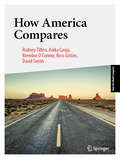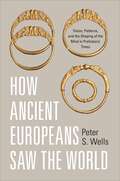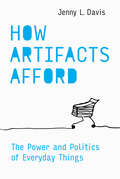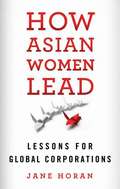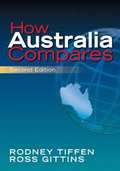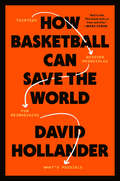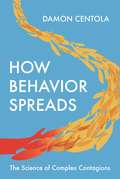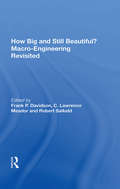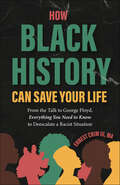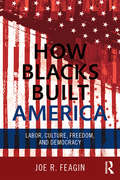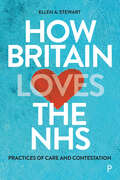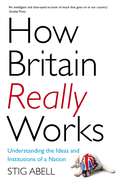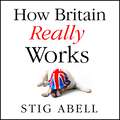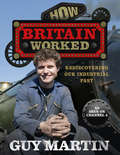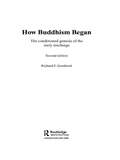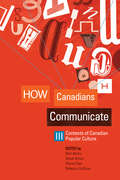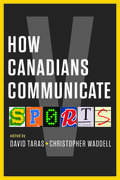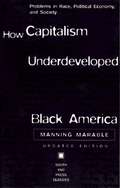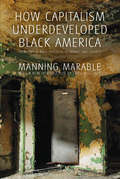- Table View
- List View
How America Compares (How the World Compares)
by Rodney Tiffen Ross Gittins David Smith Anika Gauja Brendon O'ConnorThis book is a reference work with an encyclopedic range, offering contemporary and systematic comparisons between the United States and 17 other economically advanced, stable liberal democracies, as well as some more global comparisons. It offers international data on as many aspects of social life as possible, from taxation to traffic accidents, homicide rates to health expenditure, and interest rates to internet usage. Wherever possible, it offers not only the most recent available data but also trends over decades. The discussion focuses on changes over time and comparisons between countries. Sometimes the contrasts are striking; sometimes the commonalities are more instructive. Often national political debates are conducted in a vacuum, and examining comparative data on policies, performance, and prospects can give a better perspective.
How Americans Make Race
by Clarissa Rile HaywardHow do people produce and reproduce identities? In Stories and Spaces, Clarissa Rile Hayward challenges what is sometimes called the "narrative identity thesis": the idea that people produce and reproduce identities as stories. Identities have greater staying power than one would expect them to have if they were purely and simply narrative constructions, she argues, because people institutionalize identity-stories, building them into laws, rules, and other institutions that give social actors incentives to perform their identities well, and because they objectify identity-stories, building them into material forms that actors experience with their bodies. Drawing on in-depth historical analyses of the development of racialized identities and spaces in the twentieth-century United States, and also on life-narratives collected from people who live in racialized urban and suburban spaces, Hayward shows how the institutionalization and objectification of racial identity-stories enables their practical reproduction, lending them resilience in the face of challenge and critique.
How Ancient Europeans Saw the World: Vision, Patterns, and the Shaping of the Mind in Prehistoric Times
by Peter S. WellsA revolutionary approach to how we view Europe's prehistoric cultureThe peoples who inhabited Europe during the two millennia before the Roman conquests had established urban centers, large-scale production of goods such as pottery and iron tools, a money economy, and elaborate rituals and ceremonies. Yet as Peter Wells argues here, the visual world of these late prehistoric communities was profoundly different from those of ancient Rome's literate civilization and today's industrialized societies. Drawing on startling new research in neuroscience and cognitive psychology, Wells reconstructs how the peoples of pre-Roman Europe saw the world and their place in it. He sheds new light on how they communicated their thoughts, feelings, and visual perceptions through the everyday tools they shaped, the pottery and metal ornaments they decorated, and the arrangements of objects they made in their ritual places—and how these forms and patterns in turn shaped their experience.How Ancient Europeans Saw the World offers a completely new approach to the study of Bronze Age and Iron Age Europe, and represents a major challenge to existing views about prehistoric cultures. The book demonstrates why we cannot interpret the structures that Europe's pre-Roman inhabitants built in the landscape, the ways they arranged their settlements and burial sites, or the complex patterning of their art on the basis of what these things look like to us. Rather, we must view these objects and visual patterns as they were meant to be seen by the ancient peoples who fashioned them.
How Artifacts Afford: The Power and Politics of Everyday Things (Design Thinking, Design Theory)
by Jenny L. DavisA conceptual update of affordance theory that introduces the mechanisms and conditions framework, providing a vocabulary and critical perspective. Technological affordances mediate between the features of a technology and the outcomes of engagement with that technology. The concept of affordances, which migrated from psychology to design with Donald Norman's influential 1988 book, The Design of Everyday Things, offers a useful analytical tool in technology studies--but, Jenny Davis argues in How Artifacts Afford, it is in need of a conceptual update. Davis provides just such an update, introducing the mechanisms and conditions framework, which offers both a vocabulary and necessary critical perspective for affordance analyses.
How Asian Women Lead
by Jane HoranHow Asian Women Lead provides a vastly different picture than Western-focused leadership literature, highlighting obstacles Asian women face reaching the top, and looking beneath the corporate surface to show cultural and family perspectives.
How Australia Compares
by Rodney Tiffen Ross GittinsHow Australia Compares is a handy reference that compares Australia with 17 other developed countries across a wide range of social, economic and political dimensions. Whenever possible, it gives not only snapshot comparisons from the present, but charts trends over recent decades or even longer. Encyclopaedic in scope, it provides statistics for a huge range of human activity, from taxation to traffic accidents, homicide rates to health expenditure, interest rates to internet usage. This new edition is fully revised and updated, and features two new chapters: The Howard Impact and The Search for Scoreboards. New sections include obesity, advertising, broadband internet access, childcare and corruption. Information is highly accessible with double-page spreads for each topic. Tables and graphs are presented on one page, and clear explanation and analysis on the facing page. In each discussion the focus is to put the Australian experience into international perspective, drawing out the implications for the nation's performance, policies and prospects.
How Australia Decides
by Sally YoungIn recent years, the Australian media have come under fire for their reporting of politics and election campaigns. Political reporting is said to be too influenced by commercial concerns, too obsessed with gossip and scandal, and too focused on trivia and 'sound bites' at the expense of serious issues. There are accusations of bias, sensationalism, 'lazy' journalism and 'horse-race' reporting that is obsessed with opinion polls. How Australia Decides is the first book to put these allegations to the test. Based on a four-year empirical study, Sally Young reports the results of the only systematic, historical and in-depth analysis of Australian election reporting. This groundbreaking book shows how election reporting has changed over time, and how political news audiences, news production and shifts in political campaigning are influencing media content, Ai with profound implications for Australian democracy.
How Basketball Can Save the World: 13 Guiding Principles for Reimagining What's Possible
by David HollanderA thought-provoking exploration of how basketball—and the values rooted in the game—can solve today&’s most pressing issues, from the professor behind the popular New York University courseNBA and WNBA superstars, Hall of Fame players, coaches, and leading cultural figures have all dropped by New York University Professor David Hollander&’s course &“How Basketball Can Save the World&” course to debate and give insights on how the underlying principles of the game can provide a new blueprint for addressing our diverse challenges and showing what&’s possible beyond the court.Now, in How Basketball Can Save the World, Hollander takes us out of the classroom to present a beautiful new philosophy with contributions by many of his past guests and based on values inherent to basketball, such as inclusion and the balancing of individual success with the needs of the collective. These principles move us beyond conflict and confusion toward a more harmonious and meaningful future:Positionless-ness: In basketball, players aren&’t siloed into just one position or responsibility. In life, we can learn to be more adaptive to the challenges we face by embracing a positionless mindset.Human Alchemy: We talk a lot about team chemistry, but team alchemy means the creation of something totally new—a team far greater than the sum of its parts.Sanctuary: Basketball offers players a critical space to feel safe, free, and expressive. Fostering similar spaces in the real world can encourage people to be their best, happiest, and most productive selves.Transcendence: Basketball is about defying gravity, becoming weightless, and flying higher than anyone ever has before. By seeking out this principle, we can elevate ourselves and those around us to a new plane of experience.Whether you&’re a seasoned veteran of the game or have never set foot on a court, How Basketball Can Save the World will empower you to become more resilient, tolerant, and wise in your relationship with yourself, others, and the world around you.
How Behavior Spreads: The Science of Complex Contagions (Princeton Analytical Sociology Series #3)
by Damon CentolaA new, counterintuitive theory for how social networks influence the spread of behaviorNew social movements, technologies, and public-health initiatives often struggle to take off, yet many diseases disperse rapidly without issue. Can the lessons learned from the viral diffusion of diseases be used to improve the spread of beneficial behaviors and innovations? In How Behavior Spreads, Damon Centola presents over a decade of original research examining how changes in societal behavior--in voting, health, technology, and finance—occur and the ways social networks can be used to influence how they propagate. Centola's startling findings show that the same conditions accelerating the viral expansion of an epidemic unexpectedly inhibit the spread of behaviors. While it is commonly believed that "weak ties"—long-distance connections linking acquaintances—lead to the quicker spread of behaviors, in fact the exact opposite holds true. Centola demonstrates how the most well-known, intuitive ideas about social networks have caused past diffusion efforts to fail, and how such efforts might succeed in the future. Pioneering the use of Web-based methods to understand how changes in people's social networks alter their behaviors, Centola illustrates the ways in which these insights can be applied to solve countless problems of organizational change, cultural evolution, and social innovation. His findings offer important lessons for public health workers, entrepreneurs, and activists looking to harness networks for social change.Practical and informative, How Behavior Spreads is a must-read for anyone interested in how the theory of social networks can transform our world.
How Big And Still Beautiful?: Macro- Engineering Revisited
by Frank P. DavidsonThis volume examines fundamental issues of macro-engineering—now a planetary norm—from the viewpoints of psychiatry, social science, management, and law. The contributors suggest a general theory to guide future decisions on large-scale projects and programs and analyze specific cases in the context of a set of public-interest guidelines.
How Black History Can Save Your Life: Belonging at the Breaking Point
by Ernest Crim IIIBlack History's Power to Combat RacismHow Black History Can Save Your Life by Ernest Crim III, a hate crime survivor and Anti-Racist Educator, is an essential guide for anyone seeking to combat interpersonal racism, understand the roots of discrimination, and gain actionable strategies through Black historical narratives. This black history book for adults book empowers individuals, parents, and educators with tools to challenge racism and foster equity in their communities.Using Black history to fight racism. This book builds on Crim's personal experiences, including a viral 2016 hate crime incident that profoundly shaped his career. During a night out, Crim was targeted with racial slurs, but instead of letting it defeat him, he used the situation to highlight the pervasive nature of racism in America. He captured the moment on video, sparking a national conversation about the importance of confronting and addressing discrimination. Reclaiming the stories of Black history. Crim delves deep into the stories of Black excellence, resistance, and perseverance. He equips families, parents, and educators with the tools they need to combat racism in everyday life and within schools. Through his lens as a parent and former teacher, Crim demonstrates how the untold stories of Black history hold the keys to understanding the roots of racism and how it can be untaught. Drawing on his two bestsellers—Black History Saved My Life and The ABCs of Affirming Black Children—Crim teaches readers how to deconstruct racist systems and foster equitable practices in their communities. Inside, you&’ll find: Strategies to de-escalate and combat interpersonal racism in everyday situations. Tools for parents and educators to address racism in schools and educate children through an equitable lens. Inspiring Black history stories that provide a blueprint for resilience and empowerment in the face of discrimination. If you liked The Color of Law, Stamped from the Beginning, or Seven Sisters and a Brother, you&’ll love How Black History Can Save Your Life.
How Blacks Built America: Labor, Culture, Freedom, and Democracy
by Joe R. FeaginHow Blacks Built America examines the many positive and dramatic contributions made by African Americans to this country over its long history. Almost all public and scholarly discussion of African Americans accenting their distinctive societal position, especially discussion outside black communities, has emphasized either stereotypically negative features or the negative socioeconomic conditions that they have long faced because of systemic racism. In contrast, Feagin reveals that African Americans have long been an extraordinarily important asset for this country. Without their essential contributions, indeed, there probably would not have been a United States. This is an ideal addition to courses race and ethnicity courses.
How Books, Reading and Subscription Libraries Defined Colonial Clubland in the British Empire (Routledge Studies in Cultural History #86)
by Sterling Joseph Coleman, Jr.How Books, Reading and Subscription Libraries Defined Colonial Clubland in the British Empire argues that within an entangled web of imperial, colonial and book trade networks books, reading and subscription libraries contributed to a core and peripheral criteria of clubbability used by the "select people"—clubbable settler elite—to vet the "proper sort"—clubbable indigenous elite—as they culturally, economically and socially navigated their way towards membership in colonial clubland. As a microcosm for British-controlled areas of the Caribbean, Asia and Africa, this book assesses the history, membership, growth and collection development of three colonial subscription libraries—the Penang Library in Malaysia, the General Library of the Institute of Jamaica and the Lagos Library in Nigeria—during the nineteenth and twentieth centuries. This work also examines the places these libraries occupied within the lives of their subscribers, and how the British Council reorganized these colonial subscription libraries to ensure their survival and the survival of colonial clubland in a post-colonial world. This book is designed to accommodate historians of Britain and its empire who are unfamiliar with library history, library historians who are unfamiliar with British history, and book historians who are unfamiliar with both topics.
How Britain Loves the NHS: Practices of Care and Contestation
by Ellen A. StewartEPDF and EPUB available Open Access under CC-BY-NC-ND licence. What does it mean to love a healthcare system? It is often claimed that the UK population is unusually attached to its National Health Service, and the last decade has seen increasingly visible displays of gratitude and love. While social surveys of public attitudes measure how much Britain loves the NHS, this book mobilises new empirical research to ask how Britain loves its NHS. The answer delves into a series of public practices – such as campaigning, donating and volunteering within NHS organisations – and investigates how attitudes to the NHS shape patient experience of healthcare. Stewart argues that these should be understood as practices of care for, and contestation about the future of, the healthcare system. This book offers a timely critique of both the potential, and the dysfunctions, of Britain’s complex love affair with the NHS.
How Britain Really Works: Understanding the Ideas and Institutions of a Nation
by Stig Abell'Absorbing . . . an intelligent and clear-eyed account of much that goes on in our country' Sunday TimesGetting to grips with Great Britain is harder than ever. We are a nation that chose Brexit, rejects immigration but is dependent on it, is getting older but less healthy, is more demanding of public services but less willing to pay for them, is tired of intervention abroad but wants to remain a global authority. We have an over-stretched, free health service (an idea from the 1940s that may not survive the 2020s), overcrowded prisons, a military without an evident purpose, an education system the envy of none of the Western world. How did we get here and where are we going?How Britain Really Works is a guide to Britain and its institutions (the economy, the military, schools, hospitals, the media, and more), which explains just how we got to wherever it is we are. It will not tell you what opinions to have, but will give you the information to help you reach your own. By the end, you will know how Britain works - or doesn't.'Stig Abell is an urbane, and often jaunty guide to modern Britain, in the mould of Bill Bryson' Irish Times
How Britain Really Works: Understanding the Ideas and Institutions of a Nation
by Stig Abell'Absorbing . . . an intelligent and clear-eyed account of much that goes on in our country' Sunday TimesGetting to grips with Great Britain is harder than ever. We are a nation that chose Brexit, rejects immigration but is dependent on it, is getting older but less healthy, is more demanding of public services but less willing to pay for them, is tired of intervention abroad but wants to remain a global authority. We have an over-stretched, free health service (an idea from the 1940s that may not survive the 2020s), overcrowded prisons, a military without an evident purpose, an education system the envy of none of the Western world. How did we get here and where are we going?How Britain Really Works is a guide to Britain and its institutions (the economy, the military, schools, hospitals, the media, and more), which explains just how we got to wherever it is we are. It will not tell you what opinions to have, but will give you the information to help you reach your own. By the end, you will know how Britain works - or doesn't.'Stig Abell is an urbane, and often jaunty guide to modern Britain, in the mould of Bill Bryson' Irish Times
How Britain Really Works: Understanding the Ideas and Institutions of a Nation
by Stig Abell'Absorbing . . . an intelligent and clear-eyed account of much that goes on in our country' Sunday Times'Wry and readable' GuardianGetting to grips with Great Britain is harder than ever. We are a nation that chose Brexit, rejects immigration but is dependent on it, is getting older but less healthy, is more demanding of public services but less willing to pay for them, is tired of intervention abroad but wants to remain a global authority. We have an over-stretched, free health service (an idea from the 1940s that may not survive the 2020s), overcrowded prisons, a military without an evident purpose, an education system the envy of none of the Western world. How did we get here and where are we going?How Britain Really Works is a guide to Britain and its institutions (the economy, the military, schools, hospitals, the media, and more), which explains just how we got to wherever it is we are. It will not tell you what opinions to have, but will give you the information to help you reach your own. By the end, you will know how Britain works - or doesn't.'Stig Abell is an urbane, and often jaunty guide to modern Britain, in the mould of Bill Bryson' Irish Times
How Britain Worked
by Guy MartinIt is a largely forgotten fact that Britain was the first industrialized country in the world, but Guy Martin - the cult motorcycle racer and mechanic - is about to remind us how the industrial revolution helped make Britain great. Guy shows how the discoveries made in the late 18th-19th centuries are to thank for the ease of our every day lives: in order to cook a bacon and egg sandwich in Industrial-era conditions, Guy has to restore a steam locomotive and railway to have the components delivered to the local shop; he has to bring a saw mill back into working order to be able to make a bicycle; he has to revamp a Victorian fishing trawler so he can cook himself some fish and chips, and when he decides to mow the lawn, he restores a Victorian botanical garden. After all that, he's in need of a holiday - so he sets to work restoring a Victorian holiday resort. Illustrated throughout with specially commissioned photography as well as historical images, Guy will take us through each project; his passion, enthusiasm and sheer inventiveness bringing a completely new perspective to the Industrial Revolution. He invites us to live it with him, to enjoy the nostalgia, marvel in the mechanics and learn from its legacy.
How Buddhism Began: The Conditioned Genesis of the Early Teachings (Jordan Lectures In Comparative Religion Ser. #No. 17)
by Richard F. GombrichWritten by one of the world's top scholars in the field of Pali Buddhism, this new and updated edition of How Buddhism Began, discusses various important doctrines and themes in early Buddhism. It takes 'early Buddhism' to be that reflected in the Pali canon, and to some extent assumes that these doctrines reflect the teachings of the Buddha himself. Two themes predominate. Firstly, the author argues that we cannot understand the Buddha unless we understand that he was debating with other religious teachers, notably Brahmins. The other main theme concerns metaphor, allegory and literalism. This accessible, well-written book is mandatory reading for all serious students of Buddhism.
How Canadians Communicate III
by Bart Beaty Derek Briton Gloria FilaxContexts of Canadian Popular Culture
How Canadians Communicate V: Sports
by David Taras Christopher WaddellFewer Canadians than ever are lacing up skates, swimming lengths at the pool, practicing their curve ball, and experiencing the thrill of competition. However, despite a decline in active participation, Canadians spend enormous amounts of time and money on sports, as fans and followers of sporting events and sports culture. Never has media coverage of sports been more exhaustive, and never has it been more driven by commercial interests and the need to fuel consumerism, on which corporate profits depend. But the power plays now occurring in the arena of sports are by no means solely a matter of money. At issue as well in the media capture of sports are the values that inform our daily lives, the physical and emotional health of the population, and the symbols so long central to a sense of Canadian identity. Writing from a variety of perspectives, the contributors to this collection set out to explore the impact of the media on our reception of, and attitudes toward, sports—to unpack the meanings that sports have for us as citizens and consumers. Some contributors probe the function of sports as spectacle—the escalation of violence, controversies over drug use, and the media’s coverage of tragic deaths—while others shed light on the way in which the media serve to transform sports into a vehicle for the expression of identity and nationalism. The goal is not to score points but to prompt critical discussion of why sports matter in Canadian life and culture and how they contribute to the construction of identity.
How Capitalism Underdeveloped Black America
by Manning MarableThis book records the respective histories of the different social strata within Black political economy and society.
How Capitalism Underdeveloped Black America
by Manning MarableProblems in Race, Political Economy, and Society
How Charts Lie: Getting Smarter About Visual Information
by Alberto CairoA leading data visualization expert explores the negative—and positive—influences that charts have on our perception of truth. We’ve all heard that a picture is worth a thousand words, but what if we don’t understand what we’re looking at? Social media has made charts, infographics, and diagrams ubiquitous—and easier to share than ever. We associate charts with science and reason; the flashy visuals are both appealing and persuasive. Pie charts, maps, bar and line graphs, and scatter plots (to name a few) can better inform us, revealing patterns and trends hidden behind the numbers we encounter in our lives. In short, good charts make us smarter—if we know how to read them. However, they can also lead us astray. Charts lie in a variety of ways—displaying incomplete or inaccurate data, suggesting misleading patterns, and concealing uncertainty—or are frequently misunderstood, such as the confusing cone of uncertainty maps shown on TV every hurricane season. To make matters worse, many of us are ill-equipped to interpret the visuals that politicians, journalists, advertisers, and even our employers present each day, enabling bad actors to easily manipulate them to promote their own agendas. In How Charts Lie, data visualization expert Alberto Cairo teaches us to not only spot the lies in deceptive visuals, but also to take advantage of good ones to understand complex stories. Public conversations are increasingly propelled by numbers, and to make sense of them we must be able to decode and use visual information. By examining contemporary examples ranging from election-result infographics to global GDP maps and box-office record charts, How Charts Lie demystifies an essential new literacy, one that will make us better equipped to navigate our data-driven world.
How Chiefs Became Kings: Divine Kingship and the Rise of Archaic States in Ancient Hawai'i
by Patrick Vinton KirchIn How Chiefs Became Kings, Patrick Vinton Kirch addresses a central problem in anthropological archaeology: the emergence of "archaic states" whose distinctive feature was divine kingship. Kirch takes as his focus the Hawaiian archipelago, commonly regarded as the archetype of a complex chiefdom. Integrating anthropology, linguistics, archaeology, traditional history, and theory, and drawing on significant contributions from his own four decades of research, Kirch argues that Hawaiian polities had become states before the time of Captain Cook's voyage (1778-1779). The status of most archaic states is inferred from the archaeological record. But Kirch shows that because Hawai`i's kingdoms were established relatively recently, they could be observed and recorded by Cook and other European voyagers. Substantive and provocative, this book makes a major contribution to the literature of precontact Hawai`i and illuminates Hawai`i's importance in the global theory and literature about divine kingship, archaic states, and sociopolitical evolution.
